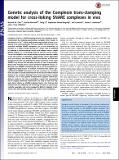| dc.contributor.author | Littleton, J. Troy | |
| dc.contributor.author | Kummel, Daniel | |
| dc.contributor.author | Baguley, Stephanie Wood | |
| dc.contributor.author | Coleman, Jeff | |
| dc.contributor.author | Rothman, James E. | |
| dc.contributor.author | Cho, Richard W. | |
| dc.contributor.author | Li, Feng, 1968 Oct. 24- | |
| dc.date.accessioned | 2015-02-05T18:57:18Z | |
| dc.date.available | 2015-02-05T18:57:18Z | |
| dc.date.issued | 2014-06 | |
| dc.date.submitted | 2014-04 | |
| dc.identifier.issn | 0027-8424 | |
| dc.identifier.issn | 1091-6490 | |
| dc.identifier.uri | http://hdl.handle.net/1721.1/93871 | |
| dc.description.abstract | Complexin (Cpx) is a SNARE-binding protein that regulates neurotransmission by clamping spontaneous synaptic vesicle fusion in the absence of Ca[superscript 2+] influx while promoting evoked release in response to an action potential. Previous studies indicated Cpx may cross-link multiple SNARE complexes via a trans interaction to function as a fusion clamp. During Ca[superscript 2+] influx, Cpx is predicted to undergo a conformational switch and collapse onto a single SNARE complex in a cis-binding mode to activate vesicle release. To test this model in vivo, we performed structure–function studies of the Cpx protein in Drosophila. Using genetic rescue approaches with cpx mutants that disrupt SNARE cross-linking, we find that manipulations that are predicted to block formation of the trans SNARE array disrupt the clamping function of Cpx. Unexpectedly, these same mutants rescue action potential-triggered release, indicating trans–SNARE cross-linking by Cpx is not a prerequisite for triggering evoked fusion. In contrast, mutations that impair Cpx-mediated cis–SNARE interactions that are necessary for transition from an open to closed conformation fail to rescue evoked release defects in cpx mutants, although they clamp spontaneous release normally. Our in vivo genetic manipulations support several predictions made by the Cpx cross-linking model, but unexpected results suggest additional mechanisms are likely to exist that regulate Cpx’s effects on SNARE-mediated fusion. Our findings also indicate that the inhibitory and activating functions of Cpx are genetically separable, and can be mapped to distinct molecular mechanisms that differentially regulate the SNARE fusion machinery. | en_US |
| dc.description.sponsorship | National Institutes of Health (U.S.) (Grant NS064750) | en_US |
| dc.description.sponsorship | National Institutes of Health (U.S.) (Grant NS40296) | en_US |
| dc.language.iso | en_US | |
| dc.publisher | National Academy of Sciences (U.S.) | en_US |
| dc.relation.isversionof | http://dx.doi.org/10.1073/pnas.1409311111 | en_US |
| dc.rights | Article is made available in accordance with the publisher's policy and may be subject to US copyright law. Please refer to the publisher's site for terms of use. | en_US |
| dc.source | National Academy of Sciences (U.S.) | en_US |
| dc.title | Genetic analysis of the Complexin trans-clamping model for cross-linking SNARE complexes in vivo | en_US |
| dc.type | Article | en_US |
| dc.identifier.citation | Cho, Richard W., Daniel Kummel, Feng Li, Stephanie Wood Baguley, Jeff Coleman, James E. Rothman, and J. Troy Littleton. “Genetic Analysis of the Complexin Trans-Clamping Model for Cross-Linking SNARE Complexes in Vivo.” Proceedings of the National Academy of Sciences 111, no. 28 (June 30, 2014): 10317–10322. | en_US |
| dc.contributor.department | Massachusetts Institute of Technology. Department of Biology | en_US |
| dc.contributor.department | Massachusetts Institute of Technology. Department of Brain and Cognitive Sciences | en_US |
| dc.contributor.department | Picower Institute for Learning and Memory | en_US |
| dc.contributor.mitauthor | Littleton, J. Troy | en_US |
| dc.contributor.mitauthor | Cho, Richard William | en_US |
| dc.relation.journal | Proceedings of the National Academy of Sciences of the United States of America | en_US |
| dc.eprint.version | Final published version | en_US |
| dc.type.uri | http://purl.org/eprint/type/JournalArticle | en_US |
| eprint.status | http://purl.org/eprint/status/PeerReviewed | en_US |
| dspace.orderedauthors | Cho, Richard W.; Kummel, Daniel; Li, Feng; Baguley, Stephanie Wood; Coleman, Jeff; Rothman, James E.; Littleton, J. Troy | en_US |
| dc.identifier.orcid | https://orcid.org/0000-0001-5576-2887 | |
| mit.license | PUBLISHER_POLICY | en_US |
| mit.metadata.status | Complete | |
